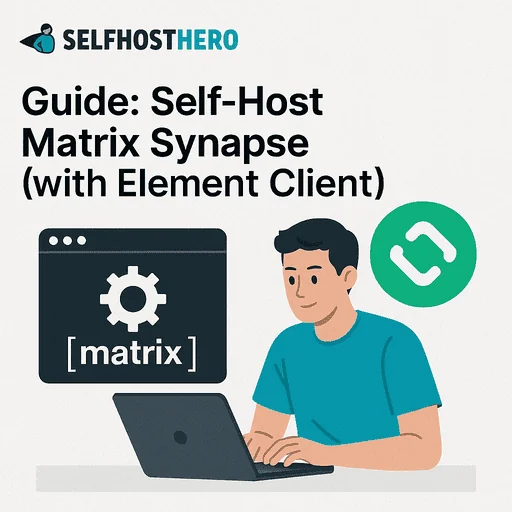Introduction
Looking to reclaim control over your communication? Matrix is a decentralized, secure, and open-source communication protocol—ideal for private messaging, team collaboration, or even full-stack alternatives to Slack or Discord. In this guide, you’ll learn how to self-host Matrix Synapse (the most widely used homeserver) and connect with Element, a powerful Matrix client.
Who is this for?
- Privacy-conscious individuals or teams
- Self-hosting enthusiasts
- Anyone seeking open-source, federated alternatives to centralized chat apps
What you’ll get:
- A working Synapse Matrix server
- Integrated Element web client
- Optional federation to other Matrix servers
Why Choose Matrix?
| Feature | Matrix (Synapse + Element) |
|---|---|
| Privacy & Control | Full data ownership, E2EE supported |
| Federation | Yes (connect to other servers) |
| Client Support | Web, Desktop, Mobile |
| Group Chats & DMs | Yes |
| Bridges to Other Tools | Yes (Slack, IRC, Discord, etc.) |
Matrix offers open, secure communication without the surveillance or vendor lock-in of big tech.
Requirements
- A VPS or local server (1–2 vCPU, 2–4 GB RAM recommended)
- Docker and Docker Compose installed
- A domain (e.g.
matrix.example.com) - Basic Linux and Docker familiarity
Step-by-Step Setup Using Docker
1. Prepare Directory
mkdir -p ~/matrix/synapse
cd ~/matrix2. Create docker-compose.yml
version: '3'
services:
synapse:
image: matrixdotorg/synapse:latest
container_name: synapse
volumes:
- ./synapse:/data
environment:
- SYNAPSE_SERVER_NAME=matrix.example.com
- SYNAPSE_REPORT_STATS=no
ports:
- 8008:8008
restart: unless-stopped
element:
image: vectorim/element-web
container_name: element
ports:
- 8080:80
restart: unless-stoppedReplace
matrix.example.comwith your domain.
3. Generate Configuration
On first run, Synapse will create configuration files.
docker-compose up -d synapseThen generate an admin user (after container starts):
docker exec -it synapse register_new_matrix_user -c /data/homeserver.yaml http://localhost:8008Follow prompts to set up your first admin account.
Configure Reverse Proxy & HTTPS
Use a reverse proxy like Nginx or Caddy to serve Synapse and Element with HTTPS. Example Nginx config for Synapse:
server {
listen 443 ssl;
server_name matrix.example.com;
location / {
proxy_pass http://localhost:8008;
proxy_set_header Host $host;
proxy_set_header X-Forwarded-For $remote_addr;
}
ssl_certificate /etc/letsencrypt/live/matrix.example.com/fullchain.pem;
ssl_certificate_key /etc/letsencrypt/live/matrix.example.com/privkey.pem;
}Add a similar block for element.example.com if served separately.
Optional Configuration
Federation
To connect with other Matrix servers:
- Ensure port 8448 is open and forwarded to Synapse
- Add appropriate DNS SRV records if not using default ports
- Confirm federation with https://federationtester.matrix.org
E2EE Backup & Verification
Enable encrypted message backup and device verification from within the Element client settings.
Bridges
Install Matrix bridges to link with:
- Slack
- Telegram
- Discord
- IRC
Bridges require additional containers or bots; check https://matrix.org/bridges.
Access and Use
- Matrix Synapse Web UI: N/A (server only)
- Element client (on port 8080): http://yourdomain.com:8080
- Mobile: Download Element app, set homeserver to your domain
FAQs
Q: Can I use my own domain?
A: Yes, and it’s recommended for federation.
Q: Is Matrix secure?
A: Yes, with end-to-end encryption supported for DMs and group chats.
Q: How does Matrix compare to Signal or Telegram?
A: Matrix is federated and self-hosted, giving you full control; Signal and Telegram are centralized.
Final Thoughts
Matrix is one of the most powerful self-hosted communication platforms. With Element, it offers a modern, privacy-respecting alternative to Slack, Discord, and WhatsApp.
Build your own communication hub—open, private, and under your control.
Support SelfhostHero: If this guide helped you, share the link, or use our affiliate recommendations to help us grow—privacy-first.

